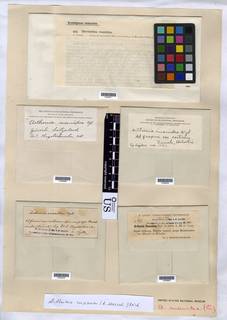
- Home
- Search
- Images
- Species Checklists
- US States: O-Z >
- US National Parks
- Central America
- South America
- US National Parks
- Southern Subpolar Region
|
|
|
|
Family: Arthoniaceae
Jaguar-spot Comma Lichen
[Arthonia rosacea Anzi, moreArthonia ruana A. Massal., Arthonia ruanidea Nyl., Arthoniopsis ruana (A. Massal.) Trevis., Arthothelium dispersum (DC.) Mudd, Arthothelium dispersum f. dispersum (DC.) Mudd, Arthothelium dispersum f. ulcerosum Erichsen, Arthothelium dispersum var. dispersum (DC.) Mudd, Arthothelium dispersum var. olivaceum Erichsen, Arthothelium rosaceum (Anzi) Zahlbr., Arthothelium ruanideum (Nyl.) Arnold, Arthothelium ruanideum f. ruanideum (Nyl.) Arnold, Arthothelium ruanideum f. ulcerosum (Erichsen) Erichsen, Arthothelium ruanideum var. olivaceum (Erichsen) Erichsen, Arthothelium ruanideum var. ruanideum (Nyl.) Arnold, Dermatina ruanidea (Nyl.) Zahlbr.] |
MB#245713 TYPE. ITALY. On bark of Fagus castanea (Massalongo 1852), A.B. Massalongo s.n. (F C0002591F, possible type) Description. Lichenized fungus. Thallus crustose, effuse, white to grayish or greenish olive; vegetative diaspores absent; prothallus brown to blackish. Photobiont trentepohlioid alga. Ascomata arthonioid apothecia, abundant, aggregated into concentric circles, irregular to substellate; disk flat, black. Ascomatal section 70–95 µm tall; epithecium dark red-brown, K+ green; hymenium 35–50 µm tall, hyaline or pale brown (K+ greenish); hypothecium 10–30 µm tall, dark red-brown, K+ dark green; paraphysoids 1–1.5 diam., numerous, the apices obscured by dense pigment. Asci pyriform, 8-spored; ascospores obovoid, hyaline to brown and warted when postmature, 7-septate to muriform, 15-25 x 7-10 µm. Pycnidia 60–80 µm diam., scarce, the wall red-brown, K+ green; conidia bacilliform, 4–6 × 1 µm. Chemistry. No secondary compounds detected by TLC. Substrate and Habitat. Corticolous on smooth-barked trees, usually near streams. Distribution. Europe, North America (primarily eastern, but also in Pacific Northwest), Asia (South Korea, Vietnam); in North Carolina recorded from the coast and mountains – expected throughout. Literature Cannon, P., D. Ertz, A. Frisch, A. Aptroot, S. Chambers, B. Coppins, N. Sanderson, J. Simkin & P. Woseley. (2020). Arthoniales: Arthoniaceae. Revisions to the British and Irish Lichens 1: 1-48. Körber, G.W. (1861) Parerga lichenologica. Ergänzungen zum Systema lichenum Germaniae 3: 193-288. Joshi, S., B.G. Lee, D.K. Upreti & J.-S. Hur. (2018) New records of Arthoniaceae from Vietnam. Mycotaxon 133: 103-112. Massalongo, A.B. (1852) Ricerche sull'autonomia dei licheni crostosi. 221 pp. (original description as Arthonia ruana). |
|
|
|


























































































